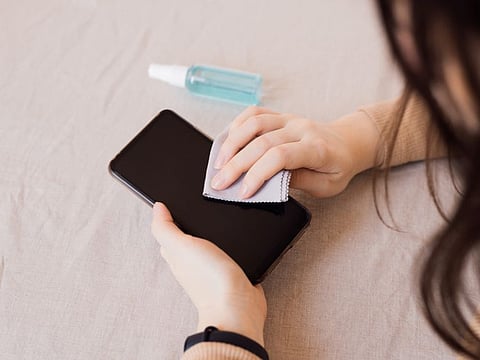Why it is a good idea to sanitise your mobile phones now
Hand hygiene practices can be negated by unclean devices and wearable tech

Abu Dhabi: You probably haven’t used your mobile phones as much as you have over the past two days, thanks to the surfeit of New Year photos, videos and greetings you have exchanged. So there is perhaps no better time than now to take the findings of a study on the need for sanitising our devices seriously.
Mobile phone and smartwatch sanitisation must be included in global infection control protocols in order to better protect public health, the Mohamed bin Rashid University of Medicine and Health Sciences (MBRU) recommended in a recent study.
The study, carried out in collaboration with Dubai Police and Bond University in Australia, found that hand hygiene practices can be negated if wearable devices remain unsanitised, particularly in healthcare settings.
Breeding grounds
In a statement, the MBRU said smart devices like mobile phones and smartwatches are a potential breeding ground for disease-causing pathogens because warm temperatures and high-touch surfaces are ideal conditions for germs to thrive. During the COVID-19 pandemic, researchers had therefore recommended the regular sanitisation of devices with wipes to remove bacteria.
“Our phones are never far from our sides; we take them everywhere with us. We all need to have a habit of regularly cleaning our mobile phones and smartwatches as much as we do our own hands,” said Professor Abiola Senok, chair of Basic Medical Sciences and professor of Microbiology and Infectious Diseases at MBRU’s College of Medicine.

“Our research findings showed that organisms identified from the hands of healthcare workers were also detected on their mobile phones and smartwatches,” said Lieutenant Colonel Dr Rashed Alghafri, director of the International Centre for Forensic Sciences in the Dubai Police’s General Department of Forensic Evidence and Criminology.
Some of the microorganisms identified on healthcare workers’ wearable tech were multidrug-resistant pathogenic bacteria. Among the randomly selected mobile phones tested, one from the unit’s COVID-19 zone showed the presence of positive SARS-CoV-2.

“Our findings are also important for global public health as organisms on the surface of mobile phones and smart watches can be carried across international borders by travelers,” said Dr Lotti Tajouri, associate professor for molecular genetics at Bond University, and a member of the Dubai Police Scientific Council.
Dr Tajouri believes that sanitation protocols, such as ultraviolet C sanitisation devices in public spaces and airports, should be investigated to mitigate the risk of microbial contamination and dissemination on smart devices.
A 2020 study by researchers at the All India Institute of Medical Sciences also issued similar recommendations for mobile phone hygiene, and also advised against device sharing during the pandemic. The United States Centres for Disease Control suggested using alcohol-based wipes containing at least 70 per cent alcohol to disinfect touchscreens.
How to sanitise mobile phones
Experts recommend cleaning smartphones regularly as they are considered high-touch surfaces.
Use sanitisation wipes. Avoid spraying disinfectants on to the screen in order to prevent moisture from spoiling your device. And make sure to unplug your device while cleaning.
Sign up for the Daily Briefing
Get the latest news and updates straight to your inbox


